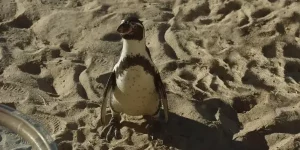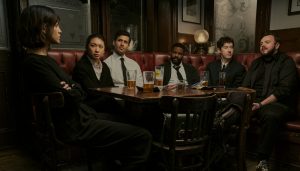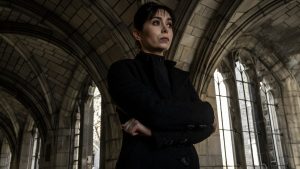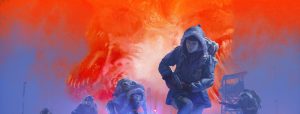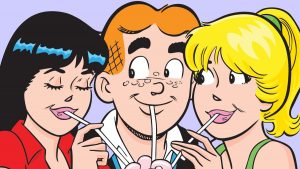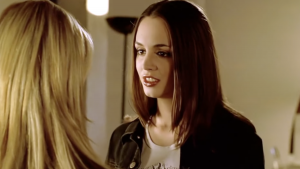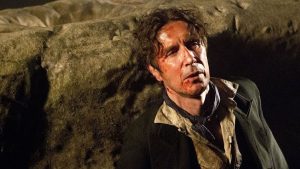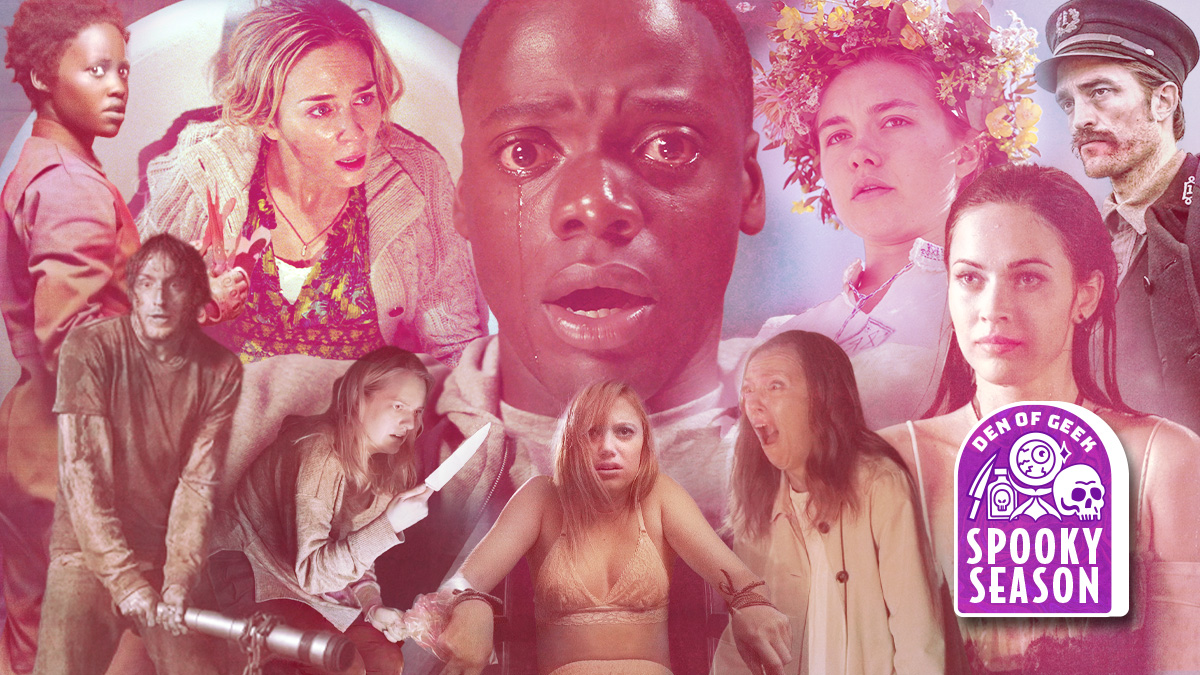
Horror has come into its own in the 21st century. This is not to say that the genre has ever not been one of the most interesting and creative in the long history of cinema. Since nearly the beginning of the art form, using moving images to scare audiences has been a gateway for aspirin filmmakers to break into the industry—or for even veterans to creatively something about the greater world by painting a landscape of anxiety.
Nonetheless, the 21st century (particularly beginning in its second decade) has brought a renewed appreciation for scary movies’ abilities to speak to audiences with more than just “boo.” With that in mind, we at Den of Geek have polled our staff and collected the below list of what we generally consider to be the best chillers of the fast quarter-century or so. Enjoy.
42. Land of the Dead (2005)
Land of the Dead does not quite stand up to George A. Romero’s first three zombie movies. Which is to say, it didn’t completely change the course of cinema. Which is also to say, it’s still a really good movie and one that somehow manages to be ahead of the social curve. 2005 was still a bit early for economic unrest to move into the mainstream, so the (literally) eat the rich ethos of Land of the Dead didn’t hit quite as hard as it would today.
That said, Land of the Dead still rules. It’s a gory zombie movie in a post-apocalyptic place, complete with a hero zombie (Eugene Clark) marching to inherit the Earth from those who think they control it. Even better, Romero gets a proper budget, allowing him to cast bigger-name actors, such as John Leguizamo and the always unhinged Dennis Hopper. More importantly, he gets money to make horrifying gore effects, paying off the promise of his early work with Tom Savini (who appears in the film) and taking the genre to its disgusting inevitable end. – Joe George
41. Final Destination (2000)
The pleasure of every slasher flick comes from the kill sequences. We judge Freddy, Jason, and Michael by the ostentatious and unusual ways they can dispatch with air-headed teens. With Final Destination, writer Jeffery Reddick brilliantly removes the middle man, no longer requiring Death to rely on his masked minions and just do it all himself. Turns out, he does it better than anyone, turning mundane locales like kitchens and bathrooms into death traps that exceed even the imagination of John Kramer.
Working with X-Files veterans Glen Morgan and James Wong, the latter of whom directed the picture, Reddick takes the slasher to its basic roots, complete with a fun group of teens—including 2000s mainstays Devon Sawa, Seann William Scott, and Ali Larter—and a mesmerizing harbinger in the form of the legendary Tony Todd. Together, these elements make Final Destination a slasher in the purest form, all killer and no filler kills. – JG
40. Suicide Club (2001)
The trailer for Suicide Club features a fax machine receiving a phone call and then printing out a bloody mess of pulp and hair, as if a malevolent figure from the other end has shoved someone into their fax machine and sent them along. Not only does no such scene ever occur in Suicide Club, but that’s not at all how fax machines work. And yet, the image perfectly captures the tone of Sion Sono’s stomach-churning movie.
On a plot level, Suicide Club follows three detectives—played by Ryō Ishibashi, Masatoshi Nagase, and Akaji Maro—as they try to discover the reason behind random mass suicides across Japan. However, the pleasure (such as it is) of the film comes not from the whodunnit, but from the absurdities that entails: scenes of a mother happily chopping up her fingers along with the carrots she prepares for dinner, and a glam rock band kicking garbage bags full of puppies. Sono never pushes the film to a coherent climax, but the movie remains effective nonetheless: nauseating, confusing, and exhilarating. – JG
39. Slither (2006)
Sure, James Gunn may make multi-billion dollar blockbusters for Disney and Warner Bros. now but he got his start at Troma, working under Lloyd Kauffman and penning Tromeo & Juliet. Gunn went on a nasty streak early in his career and nowhere is that more evident than in his debut feature Slither.
Borrowing more than a little from David Cronenberg’s Shivers, Slither infests a small South Carolina town with a horde of alien worms. The worms quickly infect the town’s richest citizen Grant Grant (Michael Rooker), who slowly devolves into a mutant glob of flesh, mixing with other infected townspeople in a sight that copies and updates the shunting scene from Society.
However, even in this early film, Gunn shows that he isn’t all gross-out gags. Slither has a keen sense of humor, with stars Nathan Fillion, Elizabeth Banks, and Clark Gregg tossing off hilarious one-liners. Even more impressive is the film’s embrace of genuine emotion, most notably in Rooker’s strangely vulnerable performance. Even when reduced to a barely human corpulent blob, Rooker convinces viewers that his heart yearns for his wife Starla (Banks). With such a unique combination, it’s no surprise that Slither sent Gunn on a trajectory toward the big leagues. – JG
38. The Others (2001)
Even today, it might be tempting to lump The Others in with other The Sixth Sense also-rans of the era. After all, The Others is a prestige studio ghost story with a twist ending. But that comparison does no favors to The Others, an emotionally rich Gothic tale written and directed by Alejandro Amenábar.
Nicole Kidman stars as Grace Stewart, a woman trying to maintain a stable life for her children after her husband Charles (Christopher Eccleston) goes missing in World War II. Grace’s task becomes complicated by a series of strange events that appear to be hauntings. Beautifully shot by Javier Aguirresarobe and performed by Kidman at her chilly best, The Others deserves more credit for bringing an old-style ghost tale to the 21st century. – JG
37. It: Chapter One (2017)
As the second adaptation of Stephen King’s gargantuan novel about a child-eating clown from outer space, It does the rare thing: the movie encapsulates clearly and succinctly what makes King’s prose so lasting to the imagination. There is a cosmic, almost Lovecraftian weirdness about the monster we call “Pennywise the Dancing Clown,” played to unnerving perfection by a smiling Bill Skarsgård; yet there is just as much fixation about what makes a small New England town live (and die). And through it all, It embraces the all-American flavor of optimism that beats beneath most of King’s books better than any picture since Stand By Me (1986).
The “Losers Club” of It, composed here of seven superbly cast child actors, experience truly nightmarish sights, but their enduring humanity somehow makes it all feel life-affirming. In truth, this movie is only half of King’s novel, but director Andy Muschietti does an impressive job of wrestling that portion into the better angels of King’s nature, even if it’s filtered through the grin of a demon. – David Crow
36. Dawn of the Dead (2004)
How do you top the zombie masterpiece that set the rules of the genre? The one from which all other entries were made? You simply don’t, but Zack Snyder’s first (and best) picture is still a hell of a good time, from the initial chaos that breaks out in a Milwaukee suburb to the final escape sequence through the zombie horde in third act. While it follows Romero’s original premise—a group of survivors holed up in a mall surrounded by the hungry undead—this Dawn of the Dead remake isn’t quite as interested in social commentary or really making any point at all. This is pure adrenaline rush courtesy of a script penned by none other than James Gunn, who packs the film with loads of action sequences, scares, and even a zombie baby because why the hell not. By the time, the survivors are mowing down zombies with their souped up rigs and chainsaws, Snyder’s more than earned this last ride through town.
Snyder is able to recapture the doomed but tongue-in-cheek tone of the original while paving his own way with the material, even if the result is sometimes derivative of 28 Days Later. While it’s not as profound or innovative as Romero’s film, there’s enough here, including an absolutely delightful Ving Rhames armed with a shotgun, to keep you hooked on the cast’s terrifying plight until the bitter end. No, this one doesn’t end on a hopeful note. This is Snyder after all, who, even then, loved to go to some pretty grim places. – John Saavedra
35. Saint Maud (2020)
When you look at it in the right crimson light, the Bible might just be one of the scariest books ever written. And what humans have spent millennia doing to each other—and themselves—in its name can certainly give you the willies, a fact that writer-director Rose Glass uses to her advantage in her unnerving feature-length debut, Saint Maud.
A movie about a young woman (future Rings of Power star Morfydd Clark) whose ideas about morality are positively medieval, Saint Maud tracks how believing one is in communication with God can lead to a horrifying descent into Hell. With evocative imagery and an even more bracing lead performance, plus rich supporting work by Jennifer Ehle, Saint Maud is a head trip that more folks need to discover since its spring 2020 rollout was muted by the pandemic. – DC
34. Raw (2016)
Rarely has a horror film tapped into female fears and fantasies so acutely as Julia Ducournau’s debut Raw. Young vegetarian Justine (Garance Marillier) is forced to eat meat as part of a hazing when she starts at university, which leads her down a dark path, one that her elder sister has already tread before her. This is a cannibal story that’s gross, visceral, and funny and speaks to certain pyschosexual urges that usually stay behind closed doors. Ducournau went on to win the Palme d’Or with her follow-up feature Titane, marking her out as one of the most interesting new voices in horror today. – Rosie Fletcher
33. Saw (2004)
It might be tempting to dismiss 2004’s Saw as little more than a proof of concept for what the series would become. After all, James Wan and Leigh Whannell made the movie for just over $1 million, most of which went to netting stars Cary Elwes and Danny Glover. The limited budget meant even gnarly scenes of people hacking off their own feet or digging into the stomach of a fellow victim had to be obscured, showing much less expensive gore than many assume.
Of course, bigger budgets for the sequels led to more complex and explicit traps, but the original Saw did have the two things that make the franchise so great: an incredibly convoluted storyline with numerous unnecessary flashbacks and reveals, and Tobin Bell as John Kramer. Even in its embryonic form, Saw keeps unpeeling layer after layer from the story, reminding viewers that they really know nothing about the world they’re watching. And at the center of it all is John Kramer, played with such conviction and empathy by Bell that we might be tempted to accept Jigsaw’s self-important self-improvement nonsense, at least for nine more movies. – JG
32. A Quiet Place (2018)
John Krasinski’s A Quiet Place set a new standard in science fiction horror but did it quietly. We don’t know where the invading aliens came from or why they are attacking, only that they are blind and hunt by sound. The Abbott family has been communicating nonverbally for 89 days. Emily Blunt’s Evelyn Abbott is pregnant. Babies cry. The silence is almost deafening in the 90-minute feature, which only has about five minutes of dialogue. The first words are spoken 40 minutes in, forcing the audience to sharpen its focus. This makes for pure motion picture storytelling. It’s enough to make you scream. — Tony Sokol
31. Drag Me to Hell (2009)
We thought we had lost Sam Raimi. The man who made the Platonic ideal of low-budget horror with Evil Dead II had joined the studio system to make three Spider-Man blockbusters. As excellent as all three of those movies are (YES, ALL THREE), fans worried that their success would give him an excuse to continue making more respectable movies like For Love of the Game and A Simple Plan, leaving horror behind.
And then demons condemn a child into eternal torment five minutes into Drag Me to Hell.
From that moment on, Raimi reminded viewers that success hadn’t softened him in the least. Drag Me to Hell turns the mean-spirited morality of EC Comics against loan officer Christine (Alison Lohman), a mild-mannered midwestern kid who denies an extension to elderly Mrs. Ganush (Lorna Raver). In return for holding the company line, Christine gets cursed by Mrs. Ganush, which includes all manner of gross-out gags, including oozing eyeballs in chocolate cakes and black goo vomit. Raimi shoots the sequences with the glee of a naughty six-year-old, reclaiming his crown as horror’s enfant terrible, even after three decades in the business. – JG
30. Nope (2022)
Jordan Peele’s third feature adds a heavy splash of sci-fi to his horror slate. This is the story of a brother and sister (Daniel Kaluuya, Keke Palmer) who run a failing ranch after their father is killed by an errant nickel falling out of the sky. When something huge appears in the sky, the two hatch a plan to get the perfect footage to prove the existence of extraterrestrial life. But underestimate an alien species at your peril…
Peele goes from strength to strength, and Nope is his biggest film yet, with at least one moment of pure horror that will stick with you long after. – RF
29. The Killing of a Sacred Deer (2017)
This distinctly unsettling horror from Yorgos Lanthimos is inspired by the Greek tragedy Iphigenia in Aulis, by Euripides. Colin Farrell plays a surgeon who invites a young man (Barry Keoghan) into his family life, causing uproar. The Killing of a Sacred Deer is a modern fable, a slow burn revenge tale of careless people having to make unthinkable choices. Farrell and Nicole Kidman as his wife are terrific, but Keoghan is the standout, at once charismatic and disquieting—he’s extremely weird but also somehow captivating, rather like the film itself. – RF
28. Overlord (2018)
Largely considered a flop when it was released theatrically in 2018, even though it touted J.J. Abrams’ name as a producer, Overlord soon garnered a cult following despite its arguably mismanaged rollout. To be fair, it’s a weird film to sum up with a snazzy one-liner, featuring as it does a WWII backdrop and an experimental serum that turns regular folk into monsters. Regardless, everyone in Overlord is operating at full capacity, with newbie director Julius Avery handling the mixed genres with aplomb as a ragtag group of soldiers fall from the sky and stumble upon a Nazi plot that’s somewhere between Saving Private Ryan, Re-Animator, Dog Soldiers and Michael Mann’s The Keep.
This action-packed body horror yarn also boasted one of the strongest up-and-coming casts around with Jovan Adepo (Babylon), Bokeem Woodbine (Halo), Pilou Asbæk (Game of Thrones), and Wyatt Russell (Thunderbolts) all scrapping to be the MVP. – Kirsten Howard
27. Sinister (2012)
Following an ill-advised foray into sci-fi with a pointless remake of The Day the Earth Stood Still, director Scott Derrickson found himself back on familiar ground with this 2012 mini-classic, which Derrickson co-scripted with C. Robert Cargill. The film follows a true crime writer named Ellison Oswalt (Ethan Hawke), who moves his family into a house where the previous occupants were brutally murdered. Hoping to write a book about the case, Oswalt discovers a box of home movies in the attic that makes him realize he’s stumbled into something far more inexplicable and dangerous than he could have imagined.
From the opening scene—a “home movie” of the family who lived in the house beforehand being hanged en masse—Derrickson sets a tone of suffocating dread. Oswalt’s viewing of the other film reels he discovers along the way is also a clever integration of the “found footage” subgenre into an otherwise traditional narrative. The movie is genuinely unnerving for most of its running time: Derrickson sustains the mood effectively too, although he goes to the jump scare well probably a bit too much. In the end, however, a string of frightening sequences, an original new menace, and Hawke’s effective portrayal of a desperate, increasingly frantic family man help Sinister leave its mark. – Don Kaye
26. The House of the Devil (2009)
Ti West’s third feature-length film is also the movie that cemented him as one of horror’s bright new auteurs. He’s made a lot of new classics in the genre before and since, but it really was with The House of the Devil where many recognized that this guy intuits the vocabulary of the genre at a granular level.
Set during the 1980s and wearing its vintage influences on its sleeve (which include religious horror movements from the 1960s and ‘70s), The House of the Devil is an exercise in knowing the anticipation of something horrible is far more dreadful than any image of babysitters being torn apart. So for almost the entirety of Devil’s 95 minutes, we must shadow star Jacqueline Donahue as she slowly comes to understand just how damned she is. When the Devil worshippers finally come for her at the end, it’s almost a relief. – DC
25. Mandy (2018)
Here we are in the latter days of Nicolas Cage’s acting career where one of the most prolific actors of a generation has become even more prolific, appearing in an apparently unending procession of bizarre genre movies. And perhaps none is more bizarre, and unapologetically psychedelic and colorful, than Panos Cosmatos’ 2018 masterpiece, Mandy. While some folks may immediately zero in on that one scene where Cage, clad in tighty-whities, chugs a handle of vodka and alternately rages and weeps, Mandy as a film, and Cage’s performance in it, are far more than a novelty or curiosity.
After all, Cage’s character Red has good reason to behave that way, having just witnessed unimaginable horrors inflicted on a loved one at the hand of an apparently satanic gang of bikers, making this a heartbreaking moment rather than a gonzo one. And then there’s the gallons of LSD that characters appear to consume throughout the movie, whose lysergic haze leaks out onto the film itself, bringing with it gorgeous colors that only make the nonstop, brutality and ever more disturbing acts of violence all the more unsettling.
Cage’s haunted Red makes for the actor’s best performance in over a decade while Cosmatos evokes heavy metal and prog rock album covers, vintage Dungeons & Dragons Monster Manual art, and other vivid horrors with ease. Mandy is not for the faint of heart, but if you’re willing to take that ride, you’ll be rewarded. – Mike Cecchini
24. Dog Soldiers (2002)
French director François Truffaut famously declared that, “There’s no such thing as an anti-war film,” arguing that the spectacle inherent to cinema makes war look exciting and attractive, even when it wants to condemn the practice (case in point: 2022’s All Quiet on the Western Front). The same may be true of werewolf pictures. On the surface, they exist to explore the bestial nature that lurks within even the most docile human. However, we as viewers cheer and do not scream when the transformation finally happens because that’s what we came to see.
Neil Marshall addresses both of those problems with his debut feature, Dog Soldiers. The film stars Sean Pertwee and Kevin McKidd as British soldiers undergoing training missions in the Scottish Highlands. There they encounter a pack of werewolves, who make like the Predator and start tearing apart these toughs. Marshall leans into the gnarly kills and band of brothers camaraderie between the troop and even gets some cool-looking werewolf shots. The result may not be an anti-war film, exactly, but it does work as an examination of the inner evil we let loose through war. – JG
23. REC (2007)
A fluff news report quickly turns into an unfathomable nightmare in this Spanish found footage film from horror directors Jaume Balagueró and Paco Plaza. The movie follows TV reporter Ángela Vidal (Manuela Velasco) and her cameraman Pablo as they shadow a company of firefighters responding to an emergency call in a Barcelona apartment building. What begins as a routine call—an old woman is having some trouble in her flat—soon turns into something much worse when the woman in question begins chomping on her would-be rescuers. And when the authorities show up to quarantine the building just as the bodies start piling up inside, all hell breaks loose.
A creepy, locked-down building, killer tenants, a shaky first-person perspective that immerses you in terror, and a mysterious top-floor apartment that may hold the answer to the whole fiasco all combine to create one of the best found footage movies ever made. The long dark hallways of this old building, and its geography and secrets, are mesmerizing, and through the camera we watch as the characters’ attempts to escape only manage to pull them deeper into the hell unfolding around them. The grueling third act twist, when Ángela and Pablo finally uncover what’s behind the quarantine, will keep you up at night. – JS
22. Jennifer’s Body (2009)
Girlfight director Karyn Kusama waded into Jennifer’s Body with the gloves off back in 2009, making a uniquely feminist cult movie in the horror genre as a result. This underrated gem always had its fans, but it’s been appreciated with more clarity in the wake of the #MeToo movement. Indeed, the core story is close to the bone. It kicks off with a group of men thoughtlessly sacrificing a young woman to further their own careers, and the carnage that follows cuts down to the marrow as the abused Jennifer (Megan Fox) utilizes a ravenous darkness inside to maintain her mental and physical health. Essential stuff. — KH
21. The Invisible Man (2020)
Leigh Whannell’s update of the classic H.G. Wells story makes some extremely shrewd choices. This isn’t a film about a deranged scientist who invents a method of making himself invisible; it’s about his wife. This is a story about domestic abuse, with Elisabeth Moss giving an impressive central performance as the abused spouse who is told her husband has taken his own life. But she knows better. This is a tense cat-and-mouser, where the cat is invisible, and no one believes the mouse: a central scene in a restaurant is deeply shocking and absolute nightmare fodder. Clever stuff. – RF
20. The Conjuring (2013)
Sometimes a bump in the night is used subtly by a filmmaker: it’s an anomaly, an inexplicable mystery in the dark. And sometimes, a director just wants to make you jump for the umpteenth occasion as their rollercoaster accelerates toward the next drop. James Wan is the latter type of storyteller, and his thrill ride achieved peak form in The Conjuring, a spectacle that’s determined to leave you smiling as much as shrieking.
What makes the original 2013 movie a cut above, though, is the effort Wan and stars Patrick Wilson and Vera Farmiga put into turning the archetypal “paranormal investigators” into sentimental superheroes. It’s the best haunted house attraction in town and strangely endearing. — DC
19. The Ring
Typically, American remakes of foreign language films are inferior copycats undeserving of their titles. It’s the same song without the music. But Gore Verbinski’s westernized reimagining of The Ring is the exception to the rule. His picture is undoubtedly the same story about a curse, a well, a creepy little girl, and a videotape, and yet it stands on its own separate from the also profoundly unsettling Japanese film Ringu (which, as it came out in 1998, just misses the cutoff for this list).
In The Ring, Naomi Watts plays a woman who makes the mistake of investigating the strange death of a friend’s daughter. Like several other classmates, the girl died seven days after watching a VHS tape marred by disturbing imagery. And when Watts’ single mother looks at it too, she gets a cryptic phone call promising her she has “seven days.” Verbinski creates a dreamlike sense of inescapable doom as his film drifts somewhere between reality and a waking nightmare. But if you’ve ever seen what lies at the bottom of The Ring’s inky black well, you know there is no real awakening from the images which have already burrowed deep inside your brain. – DC
18. Kairo (2001)
In most horror movies, the ghosts jump out and say boo or do some sort of physical damage to human protagonists. Not so in Kairo, the techno-horror film from Kiyoshi Kurosawa. His ghosts simply exist, going about their business and hardly regarding the humans. To anyone who thinks that sounds boring, I would recommend they watch the scene in which a ghost runs down a hallway toward a terrified witness. The ghost’s unnatural rhythm, the way she stumbles into a trip that never completes into a fall, the disregard for the human in the room, all of these aspects reveal an existential truth that humans hardly matter on the Earthly realm.
The ghosts in Kairo come through the internet, but Kurosawa isn’t making a film about the fear of modernity. Unlike the misguided American remake Pulse, Kairo doesn’t present computers as pits into Hell or any sort of inherently evil invention. Rather it looks at the internet as a means for increasing our loneliness, tempting humans to turn away from one another and stare at pixels on a screen. That fact makes the ghosts of Kairo all the more real, all the more believable, and all the more haunting. – JG
17. Midsommar (2019)
A horror movie that takes place almost entirely in bright daylight sounds like a gimmick—but this is the second movie from Hereditary director Ari Aster: it’s wall-to-wall trauma. Unlike Hereditary, though, Midsommar does at least have a vein of humor, as recently bereaved Dani (Florence Pugh) takes a trip with her douchebag boyfriend (Jack Reynor) and his friends to a remote Swedish village to join in their mid-summer celebrations. With Wicker Man undertones, Aster’s signature graphic deaths, and storming performances from the whole cast, this is a nightmarish psychedelic trip with one of the most delicious endings in recent memory. – RF
16. The Lighthouse (2019)
There are some who would argue that Robert Eggers’ sophomore effort is not a true horror movie. But we say those folks have lost their beans. The Lighthouse is a bizarre, claustrophobic, and ultimately maddening dip into nautical terror. Pulling as much from Lovecraft as 19th-century sailor superstitions, Eggers creates a sea-soaked fever dream that is toxically masculine where The Witch was devilishly feminine. He also provides a great two-hander opportunity for Robert Pattinson and Willem Dafoe, who call down the fury of Poseidon in performances that will sweep you away into the deep black. — DC
15. The Descent (2005)
Not receiving nearly enough attention upon its release, The Descent’s legacy has grown and grown, raising it far above even the status of cult classic. In fact, this damn well is one of the best horror movies ever made in this century or any other. Breathlessly written and directed by Neil Marshall, The Descent stars an all-woman cast and works just as well as a metaphor for the lies and deceits that rot away at our friendships as it does as a viselike exercise in grueling claustrophobic tension.
This is demonstrated when six women, five of them with lifelong histories and secrets, go on a spelunking adventure in the Appalachian Mountains. But when a oneupmanship mentality lands them in unexplored caverns, they discover a missing link of cave-dwelling humanoids (or “crawlers”) waiting for them in the dark. Yet it is really the betrayals, both emotional and (soon enough) physical, between the characters that make this film feel like a nihilistic confession. And we do mean nihilist if you do the smart thing and watch the European cut. – DC
14. The Devil’s Backbone (2001)
The first part in what is a quasi-trilogy for Guillermo del Toro—the other two chapters of which are the fairytales Pan’s Labyrinth (2006) and 2022’s stop-motion Pinocchio—The Devil’s Backbone‘s stablemates hint at the film’s blended interests. This film is a fairytale too, but one which is darker than the others as it stares for the first time into del Toro’s most loathsome monsters: fascists.
Set during the last year of the Spanish Civil War, the film follows an orphan (Fernando Tielve) who has been left in an orphanage operated by the Republican forces. It is there he also meets a ghost who would seem to befriend him during lonely days, and yet will take him quite close to seeing the face of real evil—and it wears a uniform. A beautiful and poignant masterwork, it as an immense achievement for del Toro that hinted at his larger aspirations for genre moviemaking still to come.
13. Black Swan (2010)
One of the few movies on this list to win an acting Oscar, Black Swan was an “elevated horror” film before that term became a meaningless buzzword. With this picture, director Darren Aronofsky not so subtly remakes Repulsion (1965) for a modern sensibility. He also creates a fascinating companion piece to his previous movie, The Wrestler (2008), by contrasting the self-destruction demanded by all art forms, high and low.
Yet the act of self-annihilation is genuinely thrilling in Black Swan’s case thanks to a tour de force performance by Natalie Portman as an extremely repressed ballet dancer whose childlike desire “to be perfect” ascends to a place of rapturous madness. In lesser hands, the ending could be construed as bleak and brutal, but the supreme joy on Portman’s face suggests you’ve just witnessed a triumph. – DC
12. Lake Mungo (2008)
This Australian curio from director Joel Anderson is a strange mockumentary about a girl who drowned in a dam and the implications on her family after. The movie shares traits with Twin Peaks but comes with an enormous dose of pathos, too. Alice Palmer is a troubled youngster with dark secrets who confesses to a psychic, “I feel like something bad is going to happen to me. I feel like something bad has happened to me, it hasn’t reached me yet, but it’s on its way. And it’s getting closer.” It has. It is. And when you see what Alice has seen, it’s unbearable. – RF
11. The Babadook (2014)
The stunning directorial debut of Australian filmmaker Jennifer Kent rocked both audiences and the horror community when it arrived in 2014, arguably becoming one of the films that ushered in the still-ongoing age of what has come to be called “elevated horror.” Essie Davis gives a heartbreaking performance as a young widowed mother who is either facing a supernatural entity in her home or a psychological breakdown—or perhaps both. The film sustains a mood throughout that is both genuinely terrifying and also quite moving, with the entity, in the best tradition of great horror tales, becoming a powerful metaphor for unexpressed grief. — DK
10. Us (2018)
Though Us doesn’t quite have the political clout of Jordan Peele’s debut Get Out, it definitely shows the filmmaker developing his visual style. This tale of doppelgangers terrorizing a family on vacation is distinctive and disturbing, with astonishing double performances from the main cast: Lupita Nyong’o, Winston Duke, Shahadi Wright Joseph, and Evan Alex. A violent home invasion chiller with a major twist, for the first two acts at least, Us is one of the most unsettling films of the last decade and a half. Though the very end leaves more questions than answers, the imagery will stick with you longer than any vagaries. – RF
9. 28 Days Later (2002)
In 2002, Danny Boyle and Alex Garland’s 28 Days Later revived the zombie genre for a new millennium, going on to influence everything from The Walking Dead and Charlie Brooker’s Dead Set to Zack Snyder’s Dawn of the Dead and even George A. Romero’s own Land of the Dead. The film’s “fast zombies”—they’re not actually undead at all but people infected with a rage-inducing virus that turns them into crazed killing machines—were a game-changer at the time, turning these old horror monsters into much scarier and immediate threats than the shambling hordes from decades past. But the movie’s real power is in just how much Boyle is able to accomplish on such a tiny budget. You may recall, for example, the haunting sequence in which Cillian Murphy’s Jim walks through what’s left of an evacuated London, eerily empty streets giving way to a growing sense of dread as our hero pieces together what he missed during his coma.
Things really get going when Jim, along with cabbie Frank (a superb Brendan Gleeson), Selena (Naomi Harris), and Hannah (Megan Burns), set out on a cross-country road trip through the desolate countryside to a military outpost offering salvation but is actually anything but. Boyle packs in so much beauty in these sequences despite the grim subject matter, you’ll almost forget you’re watching a horror movie at all. In fact, like most of Boyle’s genre-hopping films, 28 Days Later morphs into different things as it goes on—post-apocalyptic horror, political allegory, a rumination on the sanctity of life, an action movie—leading to a heart-stopping third act centering on Christopher Eccleston’s memorably vile baddie, a reminder that in the zombie genre, the humans that survive the end of the world often turn out to be much worse than the flesh-eating monsters beyond their walls. – JS
8. American Psycho (2000)
One of the rare instances where the film adaptation surpasses the novel, director Mary Harron and her co-writer Guinevere Turner take Brett Easton Ellis’ flawed literary satire of ‘80s Wall Streeters, American Psycho, and turn it into a truly delicious deconstruction of the fragile male ego… while still gutting ‘80s “greed is good” yuppies to boot! Spearheaded by an absolutely fearless performance from Christian Bale, American Psycho follows Patrick Bateman, a handsome, wealthy, and cripplingly twisted sociopath who spends his days wearing power ties while quoting his Sharper Image catalog, and his nights butchering women.
Reportedly, Bale’s performance was so manic that his castmates were convinced it’d be terrible until they saw the finished film. That’s because this is a horror movie that asks the audience to laugh at the vanity of its killer and how he thinks the insipid lyrics of Huey Lewis and the News’ Fore hold the secrets of the universe—or perhaps he doesn’t. Maybe he just thinks pretending to like them will allow him to get close enough to his victims to split their heads open with an ax. The elusive ambiguity of what’s real and what’s imaginary, and what’s performative by Bateman versus what about him is real (if anything), is what makes this movie as darkly funny as it is chilling. – DC
7. The Cabin in the Woods (2012)
Before superhero movies borrowed (and exhausted) their house style, writers like Drew Goddard and Joss Whedon’s meta-textual humor felt transgressive and exciting. Take The Cabin in the Woods, for example. This self-aware chiller is both a sincere, R-rated love letter to its genre and a smirking deconstruction of it. This effect is achieved by the movie placing just about every gory horror trope of the last 50 years into a blender and mixing until there’s red paste dripping off your walls.
It should be a mess, and yet, surprisingly, it’s a marvel, particularly whenever Richard Jenkins and Bradley Whitford are on hand to snark about the latest cliché we’re indulging yet again. — DC
6. Let the Right One In (2007)
People can’t leave this 2008 Swedish horror picture alone. Since its release, there’s been an American remake, a stage production, and, this October, a 10-part Showtime TV series. Tomas Alfredson’s adaptation of John Ajvide Lindquist’s novel is uniquely atmospheric, with real beauty and unforgettable sequences. (The swimming pool revenge scene in the trailer for Netflix’s Wednesday Addams series is surely an homage.) Set in the 1980s, it’s a singular love story between a young boy and a strange girl who, as she says, is… not a girl. Poetic and dark, with captivating performances from its leads, the continuing obsession is no wonder. — Louisa Mellor
5. Shaun of the Dead (2004)
Cool kids in the UK already knew the names Edgar Wright and Simon Pegg, thanks to their work on the BBC One series Spaced, but when Shaun of the Dead opened in the U.S. on Sept. 24, 2004, it overwhelmed audiences with its combination of pop culture literacy, endless visual style, and earned emotion. Shaun of the Dead takes the zombie genre away from Pittsburgh and other major American cities and sets them loose on London’s Crouch End, occupied by adult adolescents Shaun (Pegg) and Ed (Nick Frost).
Director Wright and his co-writer Pegg get a lot of mileage out of showing very reserved English people refusing to acknowledge the end of the world, but the real energy of the film comes from the way Shaun and Ed mature over the course of the film. Shaun of the Dead makes time for Shaun’s unloved stepdad (Bill Nighy) and for Shaun to belatedly declare his admiration and for girlfriend Liz (Kate Ashfield). Wright and Pegg blend these elements effortlessly, adding richness without ever forgetting to be a very scary, and very precisely edited, movie. – JG
4. It Follows (2014)
We all know the terror of being followed, either in a dream or in real life, but trying to capture that tension onscreen is a tricky process. It Follows succeeds throughout, thanks to a low-fi approach, an ingenious conceit, and wide-angle lenses to spare.
Though David Robert Mitchell’s sophomore movie plays with genre tropes, it doesn’t take them to a meta level, allowing its characters to organically address a threat that can also be interpreted in different metaphorical ways. After the credits roll, the film lingers in a place beyond the reach of comprehension. Like the entity at its center, it follows you forever, mainly because it refuses to answer any questions but also because none of us will ever escape our own deadly fate. – KH
3. The Witch (2015)
Robert Eggers’ feature debut as a writer-director remains one of the finest horror films of this or any other decade: a slow-burning and frightening look at religious conviction, humanity’s relationship with nature, and the seductive and/or sinister power of both.
In the 1630s, a rigid Puritan patriarch and his family, despite being estranged from their community, set about living as piously as possible—but the vast forest on the edge of their land has other ideas. The atmosphere, period details, and setting are brilliantly realized, while the eponymous monster is reinvented as a primal force almost beyond human understanding. Eggers remains a filmmaker to watch, and we can also thank him for introducing the magnetic Anya Taylor-Joy to the world in her first film appearance. — DK
2. Hereditary (2018)
Writer-director Ari Aster arrived on the horror scene like a Stage 4 Linda Blair possession when Hereditary premiered at Sundance in 2018. Technically a poignant and moving allegory about grief and how the things we don’t say fester, Hereditary was also the most wretchedly disturbing misery anyone had seen at the cinema in years.
The story of a small, isolated family initially dealing with the loss of a maternal grandmother, Hereditary is a slow-moving descent into the deepest, dankest of hells. For here is the inferno that nearly every member of the Graham clan thinks they deserve on some level. The most pitifully damned is Toni Collette’s Annie. The star gives a towering, career-best performance that lingers to this day… particularly when you turn out the lights. — DC
1. Get Out (2017)
Writer-director Jordan Peele’s first film is an expertly crafted race satire about the illusion of safety. It’s a remarkable debut that makes its point with wit and indelible imagery. What point? That overt racism isn’t the only danger to Black people; white liberals can also start the theme from Jaws playing in the mind of a Black man, and for good reason. What imagery? A hypnotically revolving teaspoon, a dead deer, “the Sunken Place”…
Even the title has layers. Get Out isn’t just what movie theater audiences shout at horror films; it’s what the inner voice says when you know how unsafe you are despite being told that everything’s fine. That’s what Chris (Daniel Kaluuya) keeps being assured of on his first visit with his white girlfriend’s parents. As Chris discovers, with sickening tension, things are far from fine. An award-winning, financial and critical success for Blumhouse Productions, Get Out didn’t just make bank—it made history. — LM
The post Best Horror Movies of the 21st Century appeared first on Den of Geek.
